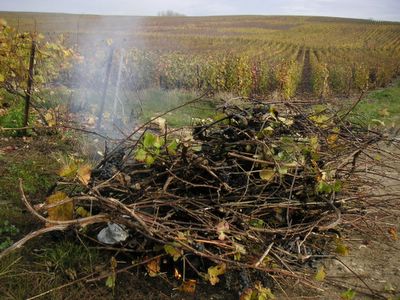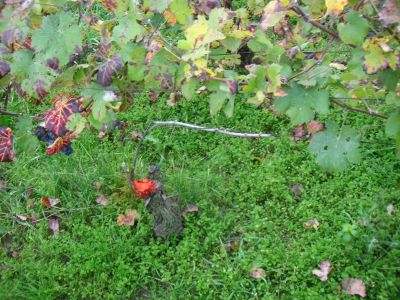The sparkling vines from Alsace recently turned the first sharp corner in life. In 30 years the crémant of the region has established itself as the secondbiggest producer of French AOC-bubbly. And the sparklers now make up one fourth of the total sales of AOC-vines from Alsace.
The biggest producer of fizz is still champagne, and there is quite a distance from the 25 milllion annual bottles of Alsace-sparklers to Champagne, where the annual production has passed 300 million bottles. Or between the 10 percent sold for exports of Alsace to the 40 percent of Champagne. But, this AOC of the French extreme East is also a lot younger - and with an accordingly smaller marketingbudget - I presume.
Price differences Quite often the price of a bottle of wine speaks for itself. With prices in a range between five and 10 euros per bottle a crémant d'Alsace costs less than half of a cheap - which does not mean bad - bottle of champagne.
The champagne brands of independent winegrowers typically are sold at prices starting at 12-13 euros. They are less charged with the prices of heavy marketing than their more exclusive collegues from the caves of
Belle Epoque-palaces and Tudor-pastiches of Épernay og Reims, and thus cost only half.
But there is still a big difference between the crémant and the champagne. So what do you get for those extra euros?
Make the most of your terroirTerroir, I suppose is the main thing you can never change. Your grapes will always be grown in a certain environment when it comes to soils, exposion and climate. In Champagne the chalky soils are praised because it enables the vines grown there to suck the minerals, which contributes to the taste. In Alsace you find a bit of everything: Granite, gneiss and at places also chalk.
The vines grown are
Pinot Blanc,
Pinot Gris,
Pinot Noir,
Riesling and
Chardonnay, that is all white grape-varieties, where two thirds of the grapes for champagne are actually - surprisingly to many - red grapes. In Alsace you may find their more rare rosé crémant as well, it is made from
Pinot Noir-grapes.
The more accurate conditions can be studied at the government authority that controles the AOC's: The
INAOWhere it comes to production method, a crémant is made in the same way as a champagne: The
methode champenoise. Even you are not allowed to call it so outside Champagne, the process remains the same: Grapes are picked by people, not machines, the second fermentation takes place in the bottle after yeast and sugar is added, and after the
prise de mousse - the creation of the bubbles - the content spends a while aging in caves.
You can blend your basewines - that is your still wines made from different grape varieties - for a crémant as well as a champagne, but the unique style of using reserve wines from other vintages for your
cuvée is unique for Champagne.
Lagring sur latteProduktionsmetoden er ellers den samme:
Methode champenoise. Selvom det ikke må hedde sådan udenfor Champagne. Mennesker - ikke maskiner - høster druerne, den anden gæring foregår i selve flasken efter tilsætning af gær og sukker, og efter
prise de mousse - hvor boblerne dannes - lagrer flaskerne en tid i kældre.
Maturing sur latteAprt from that the method of production is the same: The
methode champenoise. Even you are not allowed to call it so outside Champagne, the process remains the same: Grapes are picked by people, not machines, the second fermentation takes place in the bottle after yeast and sugar is added, and after the
prise de mousse - the creation of the bubbles - the content spends a while aging in caves.
There are not the same requirements when it comes to aging
sur latte. The Alsace-crémant must age at least nine months and a champagne at least 15 or 36 months depending whether it is a vintage or not. And the aging is expensive, because you have already had all expenses, and not yet seen even a shade of your money back.
The length of the
sur latte-proces is interesting. The dead cells of yeast talk with the champagne, and this develops more complex aromas. You divide them into three levels, where the grapes contribute with the first, the fermentation with the second and the aging with the third level. The longer the conversation, the bigger the contribution from the third layer in the final product. That is a more complex wine, which is excactly one of the elements of some champagnes, praised by champagne-
aficionados.
Finally, as you may know prestige can never be sold to expensively, which they are quite aware here.
Golden potatoesIn Denmark they do not buy that one. So far. It is interesting to compare the sales statistics for the crémant d'Alsace and champagne. Amongst the top 7 importers of crémant d'Alsace, Denmark is actually the only country that buys as much crémant d'Alsace as champagne.
Export numbers of the crémant d'Alsace-region, 2005:
(The number in the paranthesis is the export of champagne to same country, same year).
- Belgium/Luxembourg: 1.480.000 bottles (3.555.697),
- Germany: 1.267.000 bottles (3.179.665),
- Denmark: 271.000 bottles (267.318),
- The US: 141.000 bottles (7.855.631),
- Sweden: 133.000 bottles (446.627),
- The Netherlands: 87.000 bottles (845.970),
- Switzerland: 71.000 bottles (1.521.737).
Most wine regions of France produce their own crémant.No doubt it is connected with the fact that the other Alsace-wines are already very popular, and Alsace has also been a big destination for Danish holidaymakers for a long time. But the popularity is of course also linked with the price. Now, I do not know if it makes sense to use the rule of potatosales to conclude anything about champagne, which is a very different type of product. But I will do so anyway.
In Northern Europe the main parameter to sell potatoes is price, in Southern Europe it is quality. You can put it like this: In Denmark potatoes must be cheap to be sold. In France they have to look good.
I wonder if the rule does not apply for sparklers as well. In Denmark you typically drink three bottles when the French would drink one, and this one bottle will at least for still wines always be of a better quality.
But no matter what is better and who decides what is best, people's tastes in sparkling wines differ quite a lot, so I am convinced, that there are buyers for everybody. No matter name, price and complexity.
På danskCopyright: The copyright for text and photos at bobler.blogspot.com belongs to Solveig Tange. You may use my articles, photos or parts of them for non-commercial use and if I am credited as the author. Feel free to link to this site but not in your own frameset please.








